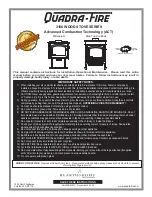
3
Congratulations !!
You are now the proud owner of an original SEDORE multi-fuel biomass stove. You are never
again limited to burning just one type of fuel. Your new SEDORE stove is Underwriters Laborato-
ries of Canada (ULC) listed and can burn any of 15 different types of fuels.
Your SEDORE stove is approved to burn the following fuels:
1)
Hardwood
2)
Softwood
3)
Wood chips
4)
Sawdust
5)
Shavings
6)
Cob corn
7)
Kernel corn
8)
Recycled cardboard cubes
9)
Treesaver firewood
10) Recycled hardwood cubes
11) Barley
12) Oats
13) Wood pellets
14) Sunflower seeds
15) Sunflower tops
Your new SEDORE woodstove burns with an entirely different principle from conventional air-tight
stoves, surpassing air-tight stoves in performance.
This manual will, step-by-step, explain the burning principles of the SEDORE, and cover many
questions you may have. You may be thinking because the SEDORE burns differently, that it is
complicated. Actually, the opposite is true. Your SEDORE is very easy to operate, and can be left
unattended most of the time.
Now, put your feet up and relax and take some time out to read through this booklet carefully. It
will orient you to how to get the most out of your new stove and cover most of the problems that
may arise.
It usually takes about three weeks after starting your new SEDORE stove, before you will feel
completely comfortable with it. This is normal, don't worry. After reading this booklet, you will be
able to identify and quickly resolve any problems that may occur.
In addition, there are many excellent videos on the internet showing the operation and main-
tenance of the SEDORE woodstove. However, if something should arise that you don't know
or can't find the answer to, don't hesitate
to call us at (519) 751-2111.
Many owners of SEDORE woodstoves only light their stove on the first cold day of the year. Be-
cause of the length of burn of each fill-up, the SEDORE only needs attention morning and night,
so you can, if you wish, keep your stove going straight through the winter until it is no longer
needed in the late spring.




































